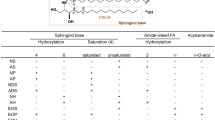Summary
DNA repair capacity of 18 fibroblast strains from patients with dysplastic nevus syndrome, 5 of them with malignant melanoma, was investigated and their colony-forming ability (D 0) after UV exposure was determined as a measurement of this. Seventeen fibroblast strains from normal donors served as controls. The dose/ response experiments included up to 11 dose levels and two UV wavelength ranges: UV-C (using a low-pressure mercury lamp emitting predominantly 254-nm light) and UV-B (artificial “sunlamp” radiation centering around 312-nm light). The exponential segments of the dose/response curves were analysed by linear regression and the negative reciprocals of the regression coefficients,D 0, were calculated for each cell strain and each wavelength range. When comparingD 0 values of individual cell strains from patients with and without melanomas with the mean value for all normal donors, only 4 out of 18 showed increased sensitivity towards UV-B. This difference, however, was not statistically significant. On the contrary, weighted-meanD 0 values for fibroblast strains from patients with and without melanoma were found to be slightly but significantly higher than those for normal donors (significance level: 5%), indicating that cell strains from these patients were less sensitive to UV light (UV-C and UV-B) of both wavelength. This result, which on the basis of current literature data is somewhat unexpected, holds true within the limits of experimental accuracy of ±12%.
Similar content being viewed by others
Abbreviations
- UV:
-
ultraviolet light
- UV-A, UV-B, UV-C:
-
UV light with wavelengths in the ranges 320–400 nm, 290–320 nm, and 230–290 nm
- D 0 (in J/m2):
-
to give 37% colony-forming ability
References
Edler L, Thielmann HW (1987) Analysis of colony-forming ability of human fibroblast strains by linear regression. Biomed J 29:807–824
Edler L, Gröger P, Thielmann HW (1985a) Computational statistics for cell survival curves. I. Evaluation of the colony-forming ability of a single cell strain by the APL function CFALINE. Comput Methods Programs Biomed 21:35–46
Edler L, Gröger P, Thielmann HW (1985b) Computational statistics for cell survival curves. II. Evaluation of the colony-forming ability of a group of cell strains by the APL function CFAGROUP. Comput Methods Programs Biomed 21:47–54
Fischer E, Thielmann HW, Neundörfer B, Rentsch FJ, Edler L, Jung EG (1982) Xeroderma pigmentosum patients from Germany: clinical symptoms and DNA repair characteristics. Arch Dermatol Res 274:229–247
Green A, Siskind V, Bain C, Alexander J (1985) Sunburn and malignant melanoma. Br J Cancer 51:393–397
Greene MH, Fraser MC, Clark WH, Elder DE, Guerry D, Kraemer KH (1984) The history of precursors to malignant melanoma. Arch Dermatol 120:18–19
Happle R (1989) Gregor Mendel und die dysplastischen Nävi. Hautarzt 40:70–76
Holly EA, Kelly JW, Shpall SN, Chiu SH (1987) Number of melanocytic nevi as a major risk factor for malignant melanoma. J Am Acad Dermatol 17:459–468
Howell JN, Greene MH, Corner RC, Maher VM, McCormick JJ (1984) Fibroblasts from patients with hereditary cutaneous malignant melanoma are abnormally sensitive to the mutagenic effect of simulated sunlight and 4-nitroquinoline 1-oxide. Proc Natl Acad Sci USA 81:1179–1183
Kraemer KH, Greene MH, Tarone R, Elder DE, Clark WH Jr. Guerry D (1983) Dysplastic nevi and cutaneous melanoma risk. Lancet 5:1076–1077
Mirzayans R, Sabour M, Paterson MC (1989) Bioreduction of 4-nitroquinoline 1-oxide in dysplastic nevus syndrome fibroblasts. Mutat Res 225:165–169
Parrish JA, Jaenicke KF, Anderson RR (1982) Erythema and melanogenesis action spectrum of normal human skin. Photochem Photobiol 36:187–191
Perera MIR, Um K, Greene MH, Waters HL, Bredberg A, Kraemer KH (1986) Hereditary dysplastic nevus syndrome: lymphoid cell ultraviolet hypermutability in association with increased melanoma susceptibility. Cancer Res 46:1005–1009
Ramsay RG, Chen P, Imray FP, Kidson C, Lavin MF, Hockey A (1982) Familial melanoma associated with dominant ultraviolet radiation sensitivity. Cancer Res 42:2909–2912
Rhodes AR, Harrist TJ, Day CL, Mihm MC Jr, Fitzpatrick TB, Sober AJ (1983) Dysplastic melanocytic nevi in histologic association with 234 primary cutaneous melanomas. J Am Acad Dermatol 9:563–574
Rigel DS, Rivers JK, Kopf AW, Friedman RJ, Vinokur AF, Heilman ER, Levenstein M (1989) Dysplastic nevi — markers for increased risk for melanoma. Cancer 63:386–389
Roth M, Boyle JM, Müller H (1988) Thymine dimer repair in fibroblasts of patients with dysplastic nevus syndrome (DNS). Experientia 44:169–171
Roush GC, Nordlund JJ, Forget B, Gruber SB, Kirkwood JM (1988) Independence of dysplastic nevi from total nevi in determining risk for nonfamilial melanoma. Prev Med 17:273–279
Smith PJ, Paterson MC (1981) Abnormal responses to mid-ultraviolet light of cultured fibroblasts from patients with disorders featuring sunlight sensitivity. Cancer Res 41:511–518
Smith PJ, Greene MH, Devlin DA, McKeen EA, Paterson MC (1982) Abnormal sensitivity to UV-radiation in cultured skin fibroblasts from patients with hereditary cutaneous malignant melanoma and dysplasic nevus syndrome. Int J Cancer 30:39–45
Smith PJ, Greene MH, Adams D, Paterson MC (1983) Abnormal responses to the carcinogen 4-nitroquinoline 1-oxide of cultured fibroblasts from patients with dysplastic nevus syndrome and hereditary cutaneous malignant melanoma. Carcinogenesis 4:911–916
Thielmann HW, Popanda O, Edler L (1982) XP patients from Germany: correlation of colony-forming ability, unscheduled DNA synthesis and single-strand breaks after UV damage in xeroderma pigmentosum fibroblasts. J Cancer Res Clin Oncol 104:263–286
Thielmann HW, Edler L, Popanda O, Friemel S (1985) Xeroderma pigmentosum patients from the Federal Republic of Germany: decrease in post-UV colony-forming ability in 30 xeroderma pigmentosum fibroblast strains is quantitatively correlated with a decrease in DNA-incising capacity. J Cancer Res Clin Oncol 109:227–240
Titus-Ernstoff L, Duray PH, Ernstoff MS, Barnhill RL, Horn PL, Kirkwood JM (1988) Dysplastic nevi in association with multiple primary melanoma. Cancer Res 48:1015–1018
Author information
Authors and Affiliations
Rights and permissions
About this article
Cite this article
Thielmann, H.W., Edler, L., Brucker, A. et al. Fibroblasts derived from patients with dysplastic nevus syndrome are not more sensitive towards 254-nm and 312-nm ultraviolet light than fibroblasts from normal donors. J Cancer Res Clin Oncol 117, 65–69 (1991). https://doi.org/10.1007/BF01613199
Received:
Accepted:
Issue Date:
DOI: https://doi.org/10.1007/BF01613199




